How to make a jute rug with your own hands?
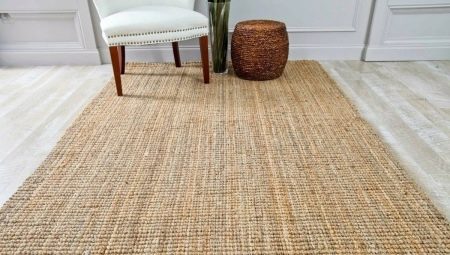
Jute crafts are a relatively new type of art. If you are interested in the possibility of creating a rug from this material, detailed master classes are described below.
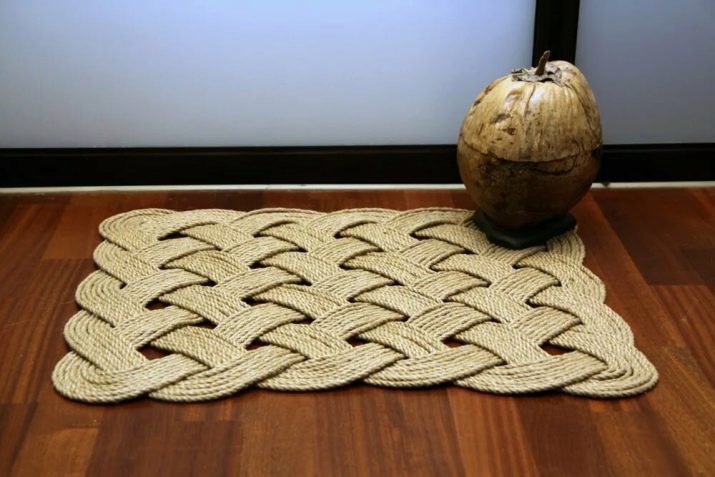
Jute selection
Jute plantations are found in America and Asia. This plant grows in the wild only on the continents of Africa and Australia. The plant belongs to spinning crops and is used by people to obtain the same type of fiber (jute).
This amazing plant is only grown in water. For a long time, people have used jute fiber for the production of coarse clothing and ropes. Modern technology has improved the structure of jute, thanks to which a variety of things can be produced from it. The range of products has greatly increased, and now twines, ropes and burlap are made from this fiber. And needlewomen use this material to make various caskets, decorate vases, and also knit carpets from it, the production of which we will consider below.
The thread contains a special bonding agent - lignin. Thanks to him, especially strong and durable products are obtained. The material has a golden hue. The shops sell yarn in different shades.
At home, natural twine is bleached or painted with water-based acrylic paints.


The property of jute to absorb moisture and not let it pass inside is used for the production of sacks and bags. Rugs made of it do not slip or wrinkle underfoot, which makes the product an excellent thing for yoga. The fibers of the plant are very tough, without processing, products from them are excellent materials for massage the feet.
The plant is immune to all kinds of chemicals. Products made from it are environmentally friendly and hypoallergenic.Jute is a rigid fiber that is obtained by twisting. The thickness of the twine depends on the number of threads. For needlework, take twine in 2 and 3 twisting threads. There is a polished twine, the yarn from it has a flat form of tightly compressed thread. The best quality processing has a light shade of jute.
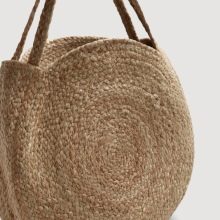


If you want to try to create a carpet with your own hands, then this material will come in handy. The twine is sold in craft stores and costs literally a penny. Jute is a natural material, but some manufacturers add impurities to it. When buying, you need to pay attention to the composition.
You can also check the strength of the material, because this is what is important for the manufacture of carpet. If the twine breaks easily, it is better not to use it and look for another. In addition, jute should keep its shape well. It is better to choose thick and dense enough jute, the color can be any, but it is advisable to use a light material. It won't get dirty, don't worry.
A rug made of this material will be very comfortable to work with and pleasant to the touch.


Step-by-step master classes
Jute is easily woven and glued, so it is easy and simple to create spectacular and very practical products from it. The shape of the carpet can be different - most often they are made round or oval, but, having gained experience, you can knit a square or even a heart. For beginners, a step-by-step description of a jute rug is suitable. Knitting is not much different from crocheting or knitting napkins, so you can use schemes for creating small squares from napkins.



Crochet
As mentioned above, the knitting patterns are the same, so you can use the crochet hook while working. This requires the following tools and materials.
- High quality twine, the thickness of which should be approx. 3 mm. The thicker the twine, the larger the hook should be and the more difficult it is to knit the product.
- Hook with a diameter of 6 mm. The hook material can be different, it all depends on personal preference. Most often, bamboo and plastic are used (they are of the same thickness along the entire length), but wood or metal will also work. Do not take a double-sided hook, because it will cling to jute fibers.
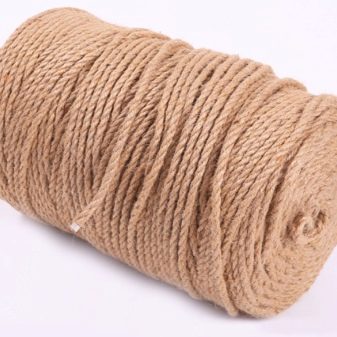

Consider knitting a round rug. First you need to create a ring of 8 air loops - this will be the base. At the end of the row, make a connecting loop and three air loops for lifting. The simplest rug is knitted in a circle without a crochet. The increase is gradual.
- 1 row. There is an increase, as in knitting amigurumi toys. To do this, make two columns in each loop and, as a result, get 16 loops in a row.
- 2 row. They continue to make an increase, increasing the size of the carpet, but now not in each loop, but after one. In the diagram, this is designated as 1 RLS, PR.
- 3 row. Again, an increase in size, but after two loops - 2 RLS, OL.
- 4 row. In this row, 3 single crochet stitches are knitted, and then an increase is made - 3 RLS, OL.
- 5 row. 4 columns and only then an increase - 4 PRS, OL.
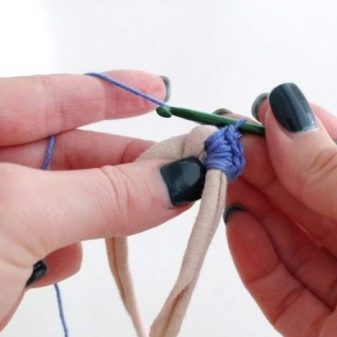

Gradually increase the size of the product in the same way. Each row should be increased by 8 loops by adding after a certain number of columns. For beauty, circles can be knitted with twine of different colors. In addition to natural colors of different shades, you can dye jute before work, as well as after preparing the product from 2 sides. You can paint the entire product or only part of it, drawing various patterns.
Most often, acrylic paints are used - they not only lie flat and do not fade over time, but also last a long time, even if you walk on them.


Openwork rectangular carpets are created according to country-style patterns. Openwork patterns are formed using posts with one or more crochets, as well as using air loops, increases and decreases. In the diagrams, the columns are indicated by a vertical line.For double crochets (CCHs), the line will be crossed out in the upper part horizontally, for a double crochet - with two lines, etc.

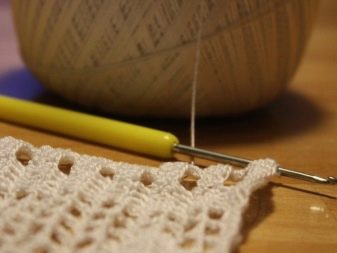


Knitting twine posts with two crochets.
- Before inserting the hook into the loop, make 2 yarns on the hook and knit each yarn with the formed loop separately, the lagging 2 loops are knitted together. With this scheme, the lifting loops are increased by one.
- Depending on the thickness of the jute, the rugs come in different sizes.
- First of all, you need to dial 4 air loops and 3 lifting loops.
- The next few rows are knitted in single crochet stitches.
- To create the desired pattern, you need to knit a column with one crochet in every third loop, and make 2 air loops between them.
- In the next row, the same column is knitted above each column, and two single crochets above the air loops.
- Then again a few next to one yarn over and repeat all the steps to the desired size.






How to knit?
Craftswomen knit original floor mats for animals from jute. Let's try to knit this with knitting needles. This requires such materials and tools.
- Leg-split. Usually a material is used that is folded in 4 strands for extra strength.
- Knitting needles, the size of which is 7 mm.
- Hook 6 mm. It is used to pull some buttonholes.



Having typed the required number of loops, they knit a simple shawl pattern from rows with only front loops. The classic way of knitting a front loop - the front wall of the loop of the previous row is picked up. The catch of the working thread goes from top to bottom. In the process of knitting, all rows are parallel. The litter is ribbed. The edges are tied with a thread of a different color with single crochet posts.
The created accessories from natural jute will always be in fashion. A knitted rug is a simple and creative way to decorate your own home.




To knit the original rug with knitting needles in the hallway, you need to purchase unpainted jute (about 1 kg), circular knitting needles No. 7 and a hook with a diameter of 6 mm. The main pattern is tangled (pearl look). In the middle, knit a braid with front loops on the odd side and purl in even rows.
- Pattern scheme: even rows - 1 front loop, 1 purl.
- Odd rows - 1 purl, 1 front.
- A set of 71 - 2 edging, 9 on the braid, and 30 loops on the sides.
- 20 rows are knitted as follows - the hem is removed, 30 loops are knitted, 9 are knitted, 30 are knitted, the last one is knitted with a purl. The edge will look like a chain.
- Row 21 starts the braid. The braid is knitted according to this pattern with an auxiliary knitting needle.
- Remove 3 loops on the auxiliary knitting needle at work. The next 3 are knitted.
- Further from the auxiliary knitting needle and further along the figure.
- 22,23,24 rows as first rows.
- 25 row - 3 knitting needles, 3 removed on the auxiliary knitting needle over work, 3 knitting needles, 3 from the auxiliary knitting needles.
- 26,27,28 rows as first rows.
- From row 29, continue to overlap the loops for the braid. A certain length of the rug is knitted according to the pattern from 21 rows. Continue to the end of the rug as the first 20 rows.





A fringe is made around the edges of the rug using a crochet hook. The fiber is cut to a specific length. The resulting threads are folded in half and crocheted into the right place. For fringes, it is better to take bleached jute. After processing in "Whiteness" the threads become looser and fluffier.
The result is a rug with a convex pattern. After completing the work, the products are rinsed in warm water and dried. It must be borne in mind that jute absorbs a lot of water, and a wet rug will be of great weight. For beginner needlewomen, working with jute will seem somewhat difficult.
With the acquisition of experience, products made from natural materials will become more elegant and original.


Weaving
Carpet is an irreplaceable part of a room's interior. How to choose your own unique and original carpet to highlight the style of your home? A jute rug will become your find and the material that will conquer with its practicality.Weaving a rug from jute threads will not be difficult even for a novice needlewoman. Jute is a natural fiber, easy to dye, practical and inexpensive. It is used to weave ropes and produce burlap material. Jute rugs come out durable, with excellent moisture resistance.
To weave a rug from jute threads, you will need:
- jute rope (1.2 thick) 60 m;
- scissors for cutting thread;
- large sheet of paper;
- bracket for fastening.


The work progress is as follows.
- Draw a large cross or the scheme of your choice on the sheet. The pattern is needed to know where the center will be, and in the process of weaving the rug came out symmetrical.
- To complete, cut the threads into two lengths. The axial threads are weaved in parallel, and the workers weave the knots. More working threads will be needed.
- Attach the cut threads to a bar. Uneven fastening is caused by threads of different lengths.
- To weave a pattern from threads: fold the thread in half, make a loop and lower it over yourself. Pull the ends that hang loosely into the loop and tighten. The ends of the threads are obtained behind the loop, and the lock is on top.
- After that there is a loop from the back to the bar, bend towards you and stretch the ends into the loop. The lock will be at the bottom.
- Thus, by interweaving and alternating freely hanging threads and knots, you will get your own unique pattern.
- After finishing the work, you need to singe the ends of the threads and sew them together.
This is how an interesting and original carpet is obtained from ordinary jute threads.


Beautiful examples
Several elements are used in the diagrams to create carpets. The main ones are loops, leaves, bends and rings. The patterns are decorated with sequins and rhinestones.
Brightness of colors and originality of the oriental style attracts the attention of many. The presence of various crafts is important for creating an interior in this style. The oriental-style carpet is distinguished by its special ornamentation and unusual weaving of threads. The products are made in red, green, blue and beige shades and are called "Eastern Tale".


For information on how to make a do-it-yourself jgut rug, see the next video.








